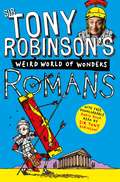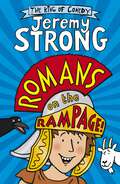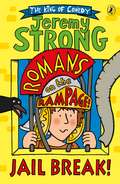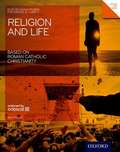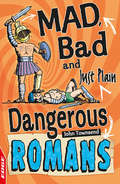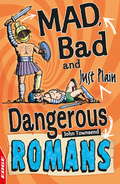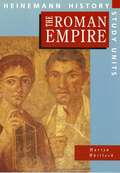Special Collections
Romans (rotten or not!)
Description: Images and books to support project and theme based learning on Roman history.
- Table View
- List View
Map of the Roman Empire, circa 150AD (UEB uncontracted0
by RnibThis map shows the extent of the Roman Empire at this time. It is surrounded by an image border, and the countries have been marked by abbreviated letters. These can be referenced in the key that runs along the bottom of the page. There is a locator dot shown, which will be at the top left of the page when the image is the right way up. In the top right corner of the page there is a north arrow. Within the image border the un-textured areas represent the sea. The Roman Empire dominates countries around the centre of the map and surrounds the Mediterranean Sea. The Roman Empire itself was surrounded by other lands, which include Europe across the top section of the image and North Africa along the bottom section.
Map of the Roman Empire (large print)
by RnibThis map shows the extent of the Roman Empire at this time. It is surrounded by an image border, and the countries have been marked by abbreviated letters. These can be referenced in the key that runs along the bottom of the page. There is a locator dot shown, which will be at the top left of the page when the image is the right way up. In the top right corner of the page there is a north arrow. Within the image border the un-textured areas represent the sea. The Roman Empire dominates countries around the centre of the map and surrounds the Mediterranean Sea. The Roman Empire itself was surrounded by other lands, which include Europe across the top section of the image and North Africa along the bottom section.
Plan of a Roman Bath House (large print)
by RnibThe image shows a plan of a typical Roman Bath House. There is a locator dot shown, which will be at the top left when the image is the correct way up. The entrance to the Bath House (aditus) is in the bottom right of the page. It is a small area with a door to the changing room (apodyterium) on the left. To the top right of the changing room is a door to a small storeroom. This is where the aromatic oils used in the bath house would be kept. To the top left of the changing room is a door to a small lobby area (vestibule) which is an entrance way into the baths from the changing rooms. Left from here is the cool room (frigidarium) with a cold pool. Up from the cool room is the warm room (tepidarium). There is a tepid pool here. To the right of this is a hot but normally dry room (laconicum). Up from the warm room is another hot room (caldarium), this time with a hot pool. This room usually has a cold fountain (labrum) as well. The water from the fountain is used to splash on the face for refreshment. Right from here is another hot room (alveus) with really hot baths. Not all bath houses have this type of room. Right from here is the furnace room (Praefurnium). This is where the fires to heat the rooms and baths are. There is a door into the room from the outside in the top left of the room. Notice that the nearer a room is to the furnace room the hotter it and its water is. Hot air is circulated under the floor and into wall cavities via channels (hypocausts), so the nearer a room is to the furnace the hotter this air will be. Only the three hot rooms have hot air wall spaces.
Plan of a Roman Bath House (UEB uncontracted)
by RnibThe image shows a plan of a typical Roman Bath House. There is a locator dot shown, which will be at the top left when the image is the correct way up. The entrance to the Bath House (aditus) is in the bottom right of the page. It is a small area with a door to the changing room (apodyterium) on the left. To the top right of the changing room is a door to a small storeroom. This is where the aromatic oils used in the bath house would be kept. To the top left of the changing room is a door to a small lobby area (vestibule) which is an entrance way into the baths from the changing rooms. Left from here is the cool room (frigidarium) with a cold pool. Up from the cool room is the warm room (tepidarium). There is a tepid pool here. To the right of this is a hot but normally dry room (laconicum). Up from the warm room is another hot room (caldarium), this time with a hot pool. This room usually has a cold fountain (labrum) as well. The water from the fountain is used to splash on the face for refreshment. Right from here is another hot room (alveus) with really hot baths. Not all bath houses have this type of room. Right from here is the furnace room (Praefurnium). This is where the fires to heat the rooms and baths are. There is a door into the room from the outside in the top left of the room. Notice that the nearer a room is to the furnace room the hotter it and its water is. Hot air is circulated under the floor and into wall cavities via channels (hypocausts), so the nearer a room is to the furnace the hotter this air will be. Only the three hot rooms have hot air wall spaces.
Roman Numerals (large print)
by RnibThis image shows Roman numerals 1 to 10 and numbers 1, 5, 10, 50, 100, 500, 1000. It also shows 2014 as a Roman numeral.
Roman Numerals (UEB contracted)
by RnibThis image shows Roman numerals 1 to 10 and numbers 1, 5, 10, 50, 100, 500, 1000. It also shows 2014 as a Roman numeral.
Roman Numerals (UEB uncontracted)
by RnibThis image shows Roman numerals 1 to 10 and numbers 1, 5, 10, 50, 100, 500, 1000. It also shows 2014 as a Roman numeral.
Roman Town plan (tactile)
by RnibThis is a street plan of a typical roman town. There is a scale in the top right of the image.
Romans
by Sir Tony RobinsonIn Sir Tony Robinson's Weird World of Wonders Romans, Sir Tony Robinson takes you on a headlong gallop through time, pointing out all the most important, funny, strange, amazing, entertaining and gory bits about the Romans! It's history, but not as we know it!Find out everything you ever needed to know in this brilliant, action-packed, fact-filled book including:- How to keep the gods happy- Why you should never ignore an omen- How to defeat an army who are riding elephants, and- How to spot a barbarianFor more funny history facts discover Sir Tony Robinson's Weird World of Wonders Egyptians.
Roman Soldier (Tactile)
by Roman SoldierThis page shows a tactile image of a Roman soldier. He is seen from the front with his arms by his side and has a short sword to his left.
Romans on the Rampage
by Jeremy StrongPerilus is a Roman boy who is crazy about chariot racing. He loves to practise in his own homemade chariot (pulled by the family goat) and dreams of riding in the Circus Maximus himself one day. But when Perilus's hero, the brilliant charioteer Scorcha , goes missing on the day of the big race, Perilus finds his wish coming true sooner than he'd imagined!
Romans on the Rampage
by Jeremy StrongPerilus and his family are in trouble again! His dad has been arrested for stealing money from the Imperial Mint. Can Croakbag the talking raven save the day once more?
GCSE Religious Studies
by Ina TaylorA new series of GCSE Religious Studies textbooks, with an added focus on improving exam skills and with free online teacher support material. This book matches the new specification for the Edexcel Religion and Life based on a Study of Roman Catholic Christianity module.
Romans
by John TownsendTime to take a sideways look at the bizarre and outrageous from throughout history - and it's all TRUE!Which mad idea poisoned thousands of Romans?Which bad emperor was top of the crazy tree? What dangerous sport was most likely to get you killed?Find out the answers to these questions inside, along with lots of facts, quizzes, and other bonkers stuff as you take a bumpy journey into the darkest crannies of Roman history with Mad, Bad and Just Plain Dangerous!
Romans
by John TownsendTime to take a sideways look at the bizarre and outrageous from throughout history - and it's all TRUE!Which mad idea poisoned thousands of Romans?Which bad emperor was top of the crazy tree? What dangerous sport was most likely to get you killed?Find out the answers to these questions inside, along with lots of facts, quizzes, and other bonkers stuff as you take a bumpy journey into the darkest crannies of Roman history with Mad, Bad and Just Plain Dangerous!
Heinemann History Study Units
by Martyn WhittockFocusing on the Roman Empire, this is one of a history series which offers teachers the flexibility to design their own scheme of work at Key Stage 3 of the National Curriculum.
The Roman Empire
by Martyn WhittockFocusing on the Roman Empire, this is one of a history series which offers teachers the flexibility to design their own scheme of work at Key Stage 3 of the National Curriculum.
Plan and side views of a Roman fort - Multi-page image (Large Print)
byThese images show two different views of a Roman fort. There is also a key on the first page. There is a locator dot shown on each page, which will be at the top left of the page when the image is the right way up. Plan view of a Roman fort: This image shows a plan of a fort surrounded by an image border on the right of the page and a key explaining the abbreviations and textures used on the two images of a Roman fort on the left of the page. There are four gatehouses in the plan, in the left (west gatehouse), top and bottom centre (north and south gatehouses), and on the right (east gatehouse). The arches which go over the road and link the two halves of the gatehouses are not shown. A central road runs from the left to right of the plan. Halfway along this road a second road runs down to the gatehouse at the bottom of the plan. On either side of this second road there are the barracks where the Roman soldiers would live. To the left of the barracks, resting against the outer wall are the toilets or Roman latrines. In the top half of the plan, up from the central road, are the other buildings of the fort. The Commander's House is to the left with an open central courtyard. Up and to the right are two workshops. To the right of these is a small square with a road leading up and out through the top centre gatehouse. Down from the courtyard is the Administrative Centre which is a large building also with a central courtyard. Right from the square are two store rooms or Roman granaries. Down from them are the stables and then two exercise yards on each side of the road.Side view of a Roman fort: There are two images on this page, at the top of the page there is a view of the fort from the west and at the bottom of the page there is a view of the fort from the east. On the left of the image at the top of the page there is the north gatehouse viewed from the side. One window can be found. To the right of the gatehouse is a section of the outer wall with crenellations (battlements). Behind this to the right is an end view of a workshop. To the right of this is the large building of the Commander's house with four columns. To the right of this is the west facing gatehouse with the arch over the road way. There would be two large wooden doors which could be closed to block the archway if the fort was being attacked. The gatehouse has two windows showing. To the right of this is another section of the outer wall. Behind this to the right is a side view of a barrack building. To the right of this is the south gatehouse viewed from the side. One window can be found. On the left of the image at the bottom of the page there is the south gatehouse viewed from the side. One window can be found. To the right of the gatehouse is a section of the outer wall with crenellations (battlements). Behind this to the right is the end view of three barrack buildings. To the right of this is the east facing gatehouse with the arch over the road way. There would be two large wooden doors which could be closed to block the archway if the fort was being attacked. The gatehouse has two windows showing. To the right of this is another section of the outer wall. Behind this to the right are the stables. To the right of this is an end view of a store room. To the right of this is the north gatehouse viewed from the side. One window can be found.
Plan and side views of a Roman fort - Multi-page image (UEB Contracted)
byThese images show two different views of a Roman fort. There is also a key on the first page. There is a locator dot shown on each page, which will be at the top left of the page when the image is the right way up. Plan view of a Roman fort: This image shows a plan of a fort surrounded by an image border on the right of the page and a key explaining the abbreviations and textures used on the two images of a Roman fort on the left of the page. There are four gatehouses in the plan, in the left (west gatehouse), top and bottom centre (north and south gatehouses), and on the right (east gatehouse). The arches which go over the road and link the two halves of the gatehouses are not shown. A central road runs from the left to right of the plan. Halfway along this road a second road runs down to the gatehouse at the bottom of the plan. On either side of this second road there are the barracks where the Roman soldiers would live. To the left of the barracks, resting against the outer wall are the toilets or Roman latrines. In the top half of the plan, up from the central road, are the other buildings of the fort. The Commander's House is to the left with an open central courtyard. Up and to the right are two workshops. To the right of these is a small square with a road leading up and out through the top centre gatehouse. Down from the courtyard is the Administrative Centre which is a large building also with a central courtyard. Right from the square are two store rooms or Roman granaries. Down from them are the stables and then two exercise yards on each side of the road.Side view of a Roman fort: There are two images on this page, at the top of the page there is a view of the fort from the west and at the bottom of the page there is a view of the fort from the east. On the left of the image at the top of the page there is the north gatehouse viewed from the side. One window can be found. To the right of the gatehouse is a section of the outer wall with crenellations (battlements). Behind this to the right is an end view of a workshop. To the right of this is the large building of the Commander's house with four columns. To the right of this is the west facing gatehouse with the arch over the road way. There would be two large wooden doors which could be closed to block the archway if the fort was being attacked. The gatehouse has two windows showing. To the right of this is another section of the outer wall. Behind this to the right is a side view of a barrack building. To the right of this is the south gatehouse viewed from the side. One window can be found. On the left of the image at the bottom of the page there is the south gatehouse viewed from the side. One window can be found. To the right of the gatehouse is a section of the outer wall with crenellations (battlements). Behind this to the right is the end view of three barrack buildings. To the right of this is the east facing gatehouse with the arch over the road way. There would be two large wooden doors which could be closed to block the archway if the fort was being attacked. The gatehouse has two windows showing. To the right of this is another section of the outer wall. Behind this to the right are the stables. To the right of this is an end view of a store room. To the right of this is the north gatehouse viewed from the side. One window can be found.
Plan and side views of a Roman fort - Multi-page image (UEB Uncontracted)
byThese images show two different views of a Roman fort. There is also a key on the first page. There is a locator dot shown on each page, which will be at the top left of the page when the image is the right way up. Plan view of a Roman fort: This image shows a plan of a fort surrounded by an image border on the right of the page and a key explaining the abbreviations and textures used on the two images of a Roman fort on the left of the page. There are four gatehouses in the plan, in the left (west gatehouse), top and bottom centre (north and south gatehouses), and on the right (east gatehouse). The arches which go over the road and link the two halves of the gatehouses are not shown. A central road runs from the left to right of the plan. Halfway along this road a second road runs down to the gatehouse at the bottom of the plan. On either side of this second road there are the barracks where the Roman soldiers would live. To the left of the barracks, resting against the outer wall are the toilets or Roman latrines. In the top half of the plan, up from the central road, are the other buildings of the fort. The Commander's House is to the left with an open central courtyard. Up and to the right are two workshops. To the right of these is a small square with a road leading up and out through the top centre gatehouse. Down from the courtyard is the Administrative Centre which is a large building also with a central courtyard. Right from the square are two store rooms or Roman granaries. Down from them are the stables and then two exercise yards on each side of the road.Side view of a Roman fort: There are two images on this page, at the top of the page there is a view of the fort from the west and at the bottom of the page there is a view of the fort from the east. On the left of the image at the top of the page there is the north gatehouse viewed from the side. One window can be found. To the right of the gatehouse is a section of the outer wall with crenellations (battlements). Behind this to the right is an end view of a workshop. To the right of this is the large building of the Commander's house with four columns. To the right of this is the west facing gatehouse with the arch over the road way. There would be two large wooden doors which could be closed to block the archway if the fort was being attacked. The gatehouse has two windows showing. To the right of this is another section of the outer wall. Behind this to the right is a side view of a barrack building. To the right of this is the south gatehouse viewed from the side. One window can be found. On the left of the image at the bottom of the page there is the south gatehouse viewed from the side. One window can be found. To the right of the gatehouse is a section of the outer wall with crenellations (battlements). Behind this to the right is the end view of three barrack buildings. To the right of this is the east facing gatehouse with the arch over the road way. There would be two large wooden doors which could be closed to block the archway if the fort was being attacked. The gatehouse has two windows showing. To the right of this is another section of the outer wall. Behind this to the right are the stables. To the right of this is an end view of a store room. To the right of this is the north gatehouse viewed from the side. One window can be found.
Roman Hypocaust system (UEB Contracted)
byThere are two images on this page, a cross section view at the top and a plan at the bottom of the page. They are both surrounded by an image border. There is a locator dot shown, which will be at the top left when the images are the correct way up.The cross section - shows the lower walls of a room at the top of the image and the underfloor area at the bottom. There is part of a furnace on the left of the image with an arched roof. Right from it is a duct (small tunnel) through the wall which allows the hot air to circulate under the floor around the support pillars and into the wall spaces. There is part of a wall above the duct and another on the right of the image. The plan also shows the furnace on the left of the image with part of the foundations of its wall surrounding it. To the right are the ducts through to the underfloor area. The foundations of the walls can be found to the right of the furnace and on the right of the image. Each wall has a ducts allowing hot air into the wall space. Between the walls is a grid of the supporting pillars.

